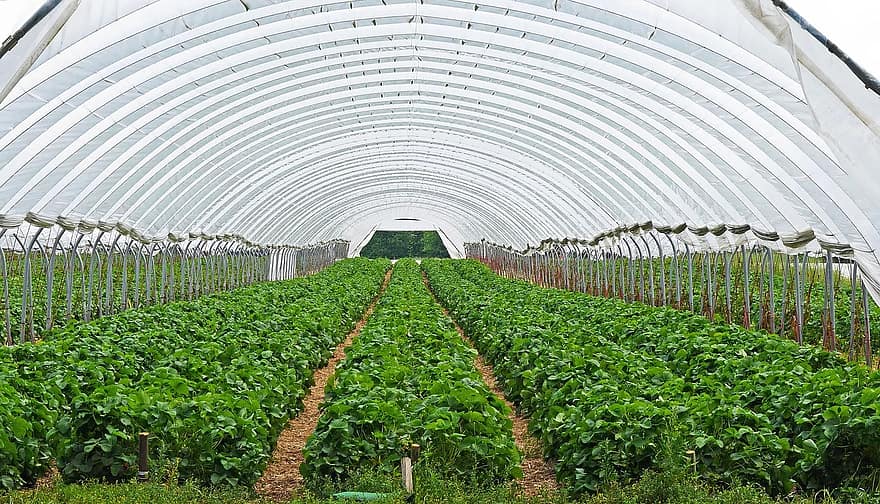Addressing the worry of how to keep plants in greenhouse from growing mold, manage the humidity, ventilation and circulation, and spacing and cleanliness indoors. We already know how worrisome it is to see mushrooms growing in the greenhouse, but what more if what’s growing indoors is a type of fungi that’s detrimental to plant health. Mold infestation in the greenhouse affects crops’ production, but the good news is it’s preventable with simple management practices.
When one sees mold growing in the greenhouse, it can pertain to different types of fungal diseases. White mold and gray mold are equally concerning to see indoors, but both also have the same management practices to prevent them from growing. The three methods below will keep your greenhouse healthy and mold-free.

Guide On How To Keep Plants In Greenhouse From Growing Mold
Humidity control
When we think of mold and fungal growth, our minds automatically go towards the greenhouse humidity level. One of the most common fungal diseases, gray mold, or Botrytis blight, is manageable with proper humidity control. And if you think about it, controlling the indoor humidity will cost you way less than the loss you’ll experience from fungal diseases.
So how does one manage the humidity in the greenhouse? The University of Massachusetts Amherst recommends proper ventilation and airflow. This article will discuss these two practices in greater detail later on.
Additionally, you can also use a dehumidifier to decrease the indoor humidity to prevent mold germination. Remember that if the greenhouse’s relative humidity goes over 85%, in addition to poor air circulation, warm temperatures and standing water will inevitably lead to the growth of mold. Therefore, ensure that the humidity level indoors should only be around 50 to 60%.
This way, the plants still get their requirement, but you’ll also not encourage mold growth.
Proper ventilation and circulation
As mentioned earlier, proper ventilation and circulation are the keys to preventing mold growth. You do this by using the vents and adding fans to the greenhouse. If you live in a humid area, a dehumidifier will also help maintain the humidity level in the greenhouse, but incorporating these two practices will be optimal.
What ventilation and air circulation do for the humidity is to ensure that potentially moldy air goes out and fresh air comes in the greenhouse. Additionally, ventilation helps regulate the temperature to prevent the growth of mold. You can start by opening the vents in the greenhouse, and then you can gauge if you’ll need to add fans later on.
Proper spacing and cleanliness
Besides the greenhouse conditions, a significant factor for preventing mold growth is proper spacing and cleanliness. We know that hygiene plays a huge role in keeping grass from growing in the greenhouse, which is also applicable to mold prevention. Much like weeds, spores of fungi quickly spreads through direct contact, air, and water.
Ensuring proper spacing will prevent infection among plants and, as a bonus, also helps with air circulation and drying time after watering. This is because standing water on the surfaces also supports the growth of mold. Additionally, since fungi spread via the air, an air purifier can kill spores that might be present indoors.
Lastly, cleanliness and sanitation throughout the surfaces, walls, and floors will help prevent fungal infection. It also includes thinning plants, removing dirty water, clippings, and potting soil, and wiping the tools you use for gardening. Infected soil and plant material can also cause mold problems, so be diligent in everything you bring and use in the greenhouse.
Common Fungi In Greenhouse
Different types of fungi can grow in the greenhouse. However, the common ones are gray mold, white mold, powdery mildew, and black sooty mold. Most greenhouse gardeners tend to see gray mold as the familiar one because it can infect almost any plant.
How To Get Rid Of Mold In Greenhouse
If you already have an existing mold in the greenhouse, you don’t need to fret because you can still get rid of it, depending on the circumstances. For example, both gray and white mold is the most problematic because you have to remove the infected plants in the greenhouse and bury them to prevent spores from spreading. On the other hand, you’re in better luck if you’ll be tackling powdery mildew because you can remove the infected leaves, and you’re good.
What about black sooty mold? Bugs like aphids cause this infection, and therefore, getting rid of bugs will solve this issue. Start removing ants as they support other bugs, and then use insecticidal soap to manage the insects and pests.
Conclusion
Greenhouse gardening will only be productive and rewarding if you know how to prevent potential problems beforehand. One of the common issues that you must learn is how to keep plants in a greenhouse from growing mold. With proper management practices like managing the humidity, ventilation, and circulation, and ensuring the spacing and cleanliness indoors, you don’t have to fear fungal diseases.
The common molds in the greenhouse are gray mold, white mold, powdery mildew, and black sooty mold. Each of them has different ways of removal, so it’s best to practice prevention instead. Overall, the practices you’ll do to prevent mold growth will benefit you, not just against fungal diseases.
Your plants will also thrive, and you can avoid other greenhouse problems. It’ll be like hitting multiple birds with one stone.

I appreciate that you brought up how you can prevent your plants from developing harmful diseases like gray mold by ensuring that humidity the levels are adequate. My uncle is thinking about growing lettuce in a greenhouse that he recently purchased last year, but he wants to keep the humidity levels consistent since the weather tends to fluctuate in his area. Maybe he should find a way to manage the humidity in his greenhouse.
Thanks good advice fari